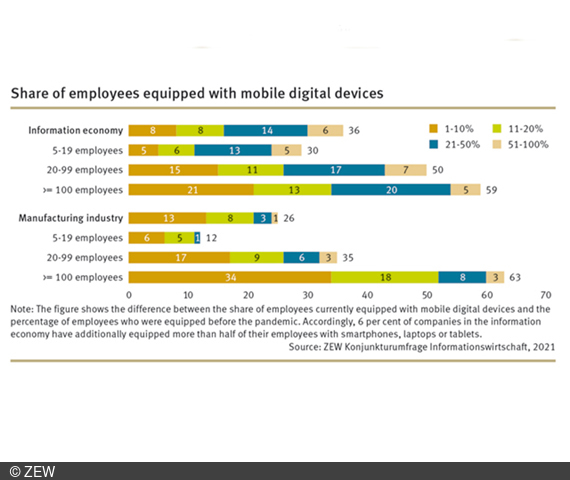Companies Expect More Working From Home Post COVID-19
Information EconomyInformation Economy and Manufacturing Industry
Soon after the outbreak of the COVID-19 pandemic, many companies in Germany expected a long-term expansion of working from home arrangements. A ZEW survey conducted in June 2021 has confirmed the companies’ early forecasts. Some companies have even increased their expectations about the use of working from home after the pandemic ends. The survey also found that many companies, especially larger ones, have equipped their employees with digital devices over the course of the pandemic.
Prior to COVID-19, around half of the companies in the information economy allowed some of their employees to work from home at least once a week. In June 2020, as the pandemic entered its fourth month, 64 per cent of companies were planning to use working from home after the pandemic has ended. One year later, that number has risen to 74 per cent. “Over the course of the pandemic, the share of companies planning to use working from home in the long-run as well as the share of employees who are expected to make use of future working from home arrangements have increased”, says Dr. Daniel Erdsiek, senior researcher in ZEW’s Digital Economy research department. “About every second company in the information economy now expects more than 20 per cent of their employees to work from home at least once a week after the pandemic ends.” By contrast, in June 2020, only one in three companies expected such an intensive use of working from home.
In the manufacturing industry, working from home is less common due to the occupational tasks which often require a physical presence at the production site. Nevertheless, manufacturers also have increased their initial expectations regarding the long-term use of working from home. Currently, around 46 per cent of companies in the manufacturing sector expect that some employees will work from home at least once a week after the end of the pandemic. In June 2020 that number was 37 per cent, while only 24 per cent of companies offered working from home arrangements before the pandemic.
More employees equipped with digital devices
Both companies and employees had to invest in technology and infrastructure in order to shift to working from home. Mobile information and communication technologies (ICT) such as smartphones, notebooks or tablets are an important component of these necessary investments. The majority of companies in the information economy (82 per cent) and in the manufacturing industry (70 per cent) had already equipped some of their employees with mobile ICT before the pandemic. However, the share of equipped employees has increased remarkably over the course of the pandemic. One-third of the companies in the information economy and one-fourth of the companies in the manufacturing industry have provided employees with additional devices. Around 60 per cent of companies with at least 100 employees have increased the number of mobile ICT provided to their employees. Around one-fourth of large companies in the information economy have equipped more than 20 per cent of their employees with mobile ICT in the wake of COVID-19. In the manufacturing industry, this is the case for around one out of ten companies.


